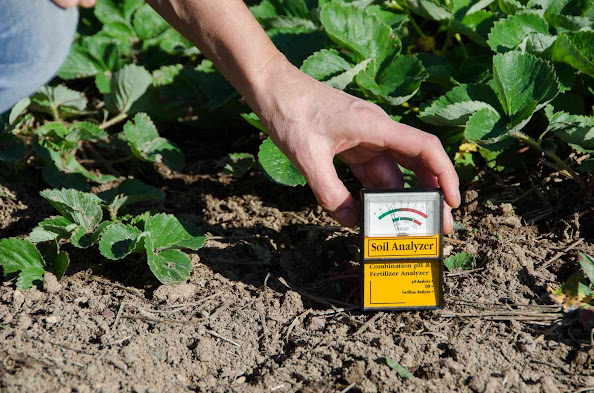How to Manage Acidic Soil? 4 Amendments
How to Manage Acidic Soil? 4 Amendments
Soil pH plays a key role in the productivity of the soil because
it controls nutrients availability and activities of microorganisms. Typically
soil pH ranges between 5.5 and 8.0 while ideal soil pH for most
prairie crops to show optimum growth is 6.5
to 6.8.
If you want to grow certain plants,
including vegetables, and lawn grasses or crops, acidic soil (pH <5.5) can pose
serious problem. Generally, most of the plants struggle to show normal growth
in a soil that is too acidic because the acidity prevents them from absorbing
nutrients from the soil.
 |
| Soil pH Testing |
Acidic Soil:
Moderate
Acidic Soil: 5.6 to 6.0
Strongly
Acidic Soil: 5.1-5.5
Very
strongly Acidic Soil: <5.0
Effects of Soil
Hyperacidity:
Low pH
accelerates the solubility of Zinc, Iron and Aluminum that results in toxic
soil conditions.
Uptake
of Nitrogen and Phosphorus is negatively affected.
Causes
decline in productivity
Influences
microbial activity and decomposition of organic matter
There are some amendments that can
help increase the pH or decrease the acidity of the soil. However, such
amendments should not be added to soil unless soil is properly tested.
Lime
Among the efficient amendments to
manage acidic soil is the application of pulverized limestone or dolomite
limestone. Dolomite contains magnesium (Mg) plus calcium carbonate (CaCO3)
while lime contains only CaCO3. For garden, you should often opt for
dolomite limestone, agricultural lime, or garden lime. Moreover, proper care
should be taken while using other forms of lime such as hydrated lime or
quicklime.
Recommended rate of application:
In order to raise the pH of soil by
one level (that is from pH-4 to pH-5), it is normally advised to add 5-10 pounds
of lime per 100 ft2 of garden soil. It will take more than the
recommended rate to increase the pH if your soil is clay.
Bone meal is a wonderful source of
calcium and may gradually improve the pH of your soil. It works best on soils
that are just mildly acidic and is not a rapid remedy.
Recommended rate of application:
Bone meal is normally applied at a
rate of 5 pounds per 50 ft2. However, to further increase pH, rate
of bone meal can be doubled.
Compost
Continue to apply high-quality compost
to the area once you have adjusted the pH. While doing this won't immediately
change the pH of the soil, over time it will contribute to its improvement and
supply nearby plants with essential nutrients as you work to reduce the soil's
acidity. Depending on what you're growing there, add at least two to three
inches of compost annually, either to the soil's top or deeper. Simply top-dress
the space with compost if perennials, shrubs, or trees are to be grown there.
Dig it into the top few inches of soil at or just before planting time, or at
the conclusion of the growing season. If it's a new planting area or one then
replenish it every year, like a vegetable garden.
Wood Ash
Wood ashes can also be used to manage
acidic soil. If you choose this method, just be careful not to burn any treated
wood or black walnut, as these are typically poisonous to other flora. If you
choose to use wood ash, be sure to dig it into the soil; if you don't, the
tiny, dusty particles will just fly away.
Recommended rate of application:
Fall is the ideal time to apply wood
ash. Wood Ash should be applied at a rate of 5 to 10 pounds per 100 ft2.
Conclusion:
It is concluded that soil pH must be
tested before the application of amendments. Also, management of acidic soil is
not tough, however, it takes time and therefore must be dealt patiently. All of
the above amendments (Lime, Bone meal, wood ash and compost) whether applied
individually or in combination are helpful in yielding the desired results.
Comments
Post a Comment